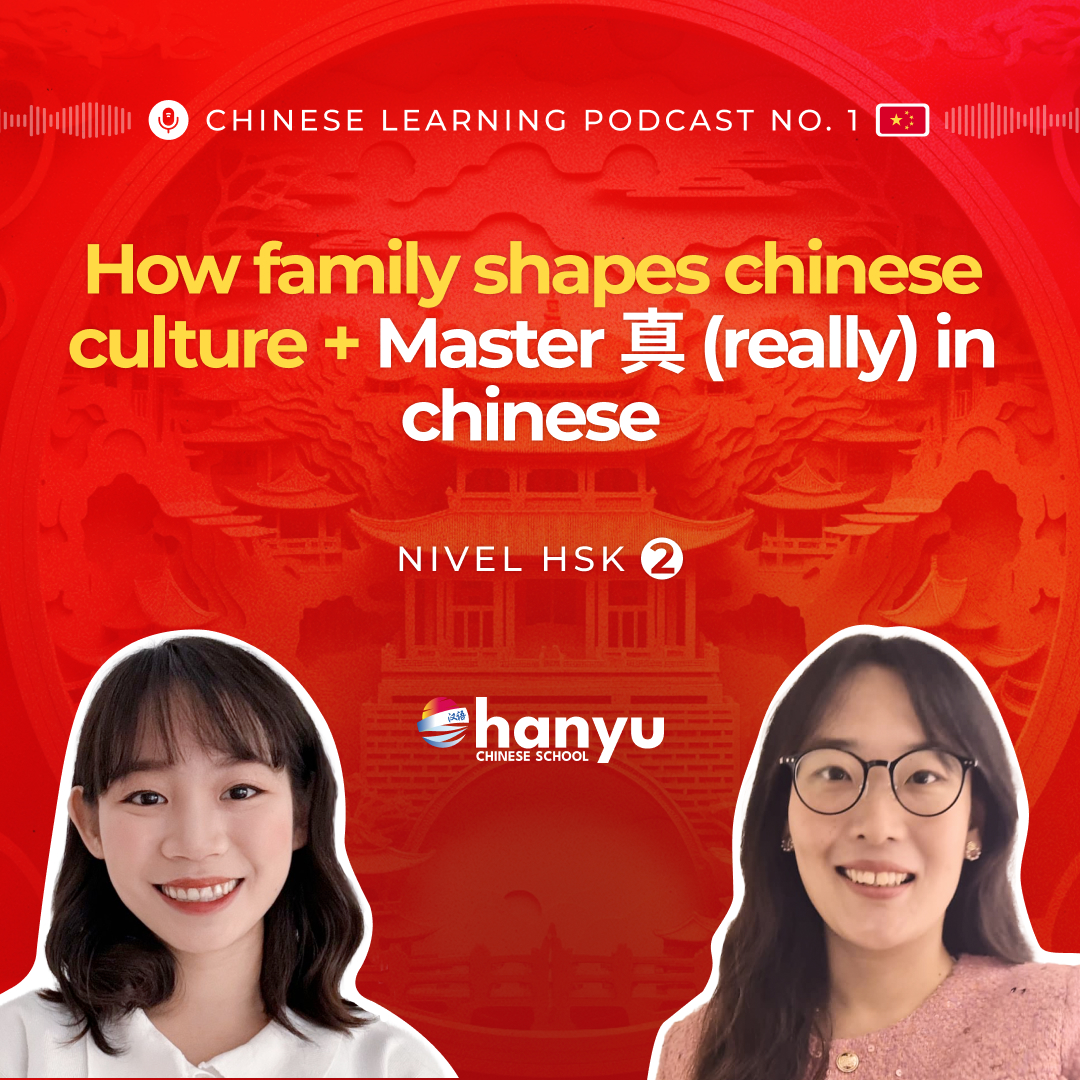Episode Transcript
[00:00:00] Speaker A: Foreign.
Welcome to episode two of the Haoyu Chinese School podcast and you go to space for learning practical Chinese in a fun and real life way. I'm Melanie, your old friend and I'm here with our remit, Vicky. How are you today?
Hi, everyone.
[00:00:29] Speaker B: Hi, Ni.
I'm so happy to be here. Today is our first time doing this episode together. I'm so excited. And because we are also learning two expression that we use in daily Chinese which is and.
And both of them. They are translated as together, but they are not the same.
[00:00:57] Speaker A: Exactly. And we'll learn when to use each of them correctly in everyday conversations. Plus, we've got a cultural twist today that many of you will find surprising. We're talking about the so called TikTok refugees and why many of them struggle when they move to Xiaohongshu, another Chinese social media app.
[00:01:22] Speaker B: Yes. And if you're curious about our expression, how to use the expression I mentioned, or if you just want to know how to avoid mistakes in Chinese social media, this episode is for you.
[00:01:38] Speaker A: Yeah. So let's jump in.
So we're gonna start it with a dialogue. The context is Content creator Melanie wants to start using Xiao Hongshu instead of TikTok and ask Vicky for advice. The conversation uses and naturally I'll start.
[00:02:46] Speaker B: Woman.
[00:03:01] Speaker A: Okay.
Yeah. So we're gonna start with our grammar.
So let's break down what we just heard. Today's grammar point is the difference between and.
[00:03:18] Speaker B: Yeah, let's start with.
It means together.
It's used before a verb to talk about doing something together.
You often see in everyday activities like eating, studying or traveling. Let's see the structure. You can see it's subject plus introduction plus verb and object. We can have some examples here.
[00:03:45] Speaker A: Woman.
[00:03:48] Speaker B: Let'S eat together.
I want to go to Beijing with you.
[00:04:01] Speaker A: Very nice. Now, what about.
[00:04:06] Speaker B: Well, is a bit different. It means to be together in the same place. It's more about physical presence or emotional closeness.
In the structure we can see subject zai, qi verb or subject verb.
Let's see some examples.
They really like being together.
We don't live together.
[00:04:46] Speaker A: So focuses on doing something together while focuses on being physically or emotionally together.
[00:04:57] Speaker B: Exactly. One useful trick is to use iqi when the activity is the key.
Use Taiichi when location or closeness is the focus.
Oh, and another advice is when we use taiichi. It's also used in a romantic context like they've been together for three years.
[00:05:34] Speaker A: And IQI is great for teamwork, online learning or casual plans with friends.
Now it's your turn. So here Is our challenge question for today. Here's a quick review with Fill in the blank.
[00:05:54] Speaker B: Yeah. Complete this sentence.
We like studying together.
[00:06:06] Speaker A: Yeah. So when you're ready, drop your answer in the comments. We'll reveal the correct answer later in this episode and give you feedback too.
Okay, so we gonna review our dialogue. So please try to focus on the difference between IQI and Zaiqi.
Do you want to do Xiao Hongshu with me?
[00:06:40] Speaker B: Wait, yeah.
[00:06:44] Speaker A: Oh, let's go back to the dialogue.
[00:06:46] Speaker B: Yeah, yeah, yeah, yeah.
We can work on together, but being together while doing it, it's a bit difficult because we don't live together.
[00:07:21] Speaker A: All right, then let's study together instead.
[00:07:29] Speaker B: Sure. I like studying together, woman.
[00:07:38] Speaker A: In the future, we can also make videos together.
[00:07:51] Speaker B: Yes, but we'll have to find time since we don't live together. It's not that easy.
[00:08:04] Speaker A: No worries. We can do it online together.
Okay, so did you notice the difference between and.
Now let's move on our cultural points. So the TikTok refugees and let's talk about the digital migration.
Sort of.
[00:08:31] Speaker B: Yeah, that's right. We're gonna talk about the TikTok refugees or in Chinese, TikTok naming that are people that got banned or Shadow banned on TikTok and they move to an application called Xiaohongshu.
[00:08:51] Speaker A: Literally.
Literally, that means Little Red book. Don't worry, it has nothing to do with politics. Is actually a social media app that's a mix of Instagram, Pinterest and the trip of the weather, but with Chinese characteristics.
[00:09:13] Speaker B: Yeah, Xiaohongshu started as a shopping review app especially for beauty and fashion.
But nowadays it's more than that.
People post about their travel, study tips, daily life, food and also language learning too.
[00:09:37] Speaker A: Here is the twist. Many foreign content creators think Xiao Hongshu is like TikTok but actually it's not. The Chinese different. The audience is different and most importantly the al. The algorithm is different.
[00:09:59] Speaker B: Yeah, let's unpack that first. The tone Tik Tok rebounds boneless speed and shock value while Sha rewards trust and useful. It's more about community.
[00:10:16] Speaker A: Right?
People on Xiaohongshu want real recommendations, personal stories and useful content. You will see lots of posts titled what I learned after one year in China or my skin care routine for oily skin. Honest, calm and personal.
[00:10:41] Speaker B: Even the aesthetics are different on Xiaohongshu. Soft lighting, clean layout, pastel tones. They do really well.
While TikTok is more about flashy transitions, loud.
[00:11:00] Speaker A: Oh, and the comments are really different too.
TikTok comments are fast and chaotic on Xiaohong Shu users leave long thoughtful replies and expect you to reply back exactly.
[00:11:19] Speaker B: So if you want to be a content creator that wants to grow in Sha Honshu, here's some essential of to do and not to do.
So let's start with the not to do list.
First, don't use extreme clickbait phrases like this changed my life forever or shocking truth. They usually get ignored or reported.
And 2 don't copy paste TikTok content.
Sha Honshu values identity, sincerity and context so a quick trend dance might look too too lazy.
3 Don't ignore comment this application runs by engagement, so if you don't reply it's like no algorithm love.
4.
Don't overload hashtags 35 would be okay.
5.
Don't criticize China or post sensitive topics.
You probably gonna get blocked permanently.
[00:12:36] Speaker A: Yeah, thank you for a good advice. So please be careful and so what should you do? So the to do list is first one personal stories and reflections how I passed HSK2 in three months will go further than five hacks to learn Chinese fast.
Next one useful tips study routines apps you use, Cafe recommendations in Shanghai, anything practical and clean Visual design so the Canva style graphics and handwritten notes, aesthetics, photos of your Chinese textbook setup and the engagement. Ask a question your post reply to every comment. Be a friendly human.
[00:13:38] Speaker B: Yeah. One thing that many Western users don't know about Shaohongshu is that it's very popular among Chinese women between 18 and 35 years old, especially in Uran areas.
[00:13:56] Speaker A: Yes. So if you're posting about lifestyle, fashion, skincare, study routines or life abroad, this is your cloud.
[00:14:07] Speaker B: Plus language learners do really well. Some foreign foreigners have gained lots of popularity and followers by sharing their Chinese study journey, the Good Things and the Bad Things.
[00:14:25] Speaker A: Also, because Xiaohong Shu is mostly used in Mainland China, it's a great way to practice reading real life Mandarin from native users.
[00:14:37] Speaker B: One thing we love there's not much trolling. The vibe is positive, curious and respectful.
[00:14:45] Speaker A: Yeah. So if you're tired of the chaos on the other apps, Shah Hongshu might be a nice breath of fresh air for you.
[00:14:55] Speaker B: Have you used Sha Honshu before?
Do you follow any creator there?
Let us know on the comments and share your profile if you're brave.
[00:15:08] Speaker A: All right, now let's move on to the correct answer to our fill in the gap sentence from earlier woman.
[00:15:25] Speaker B: We like studying together.
[00:15:28] Speaker A: Thank you Vicki. So if you wrote great job, that's the right word to show you're doing something with someone.
[00:15:37] Speaker B: And one more thing, a common mistake is writing instead.
Remember that means to be together physically, not to do something together.
[00:15:55] Speaker A: Yes. And if you're not sure, rewind the grammar section and listen again. Repetition helps.
[00:16:07] Speaker B: Now it's your turn to get creative. In the comments, write your own sentence with and.
[00:16:18] Speaker A: Yeah, so it can be something simple from your daily life, like I like eating with my family.
[00:16:32] Speaker B: Or maybe something fun like I'm happy when I'm with my cat.
[00:16:44] Speaker A: Write your sentence below and we'll try to reply and give feedback.
Let's quickly recap what we learned today.
So today we have talked about the end means together, doing something together and physically or eventually together. And use before a verb like to eat, to study, to do, use for living together, relationships, physical presence.
And for the culture we learned TikTok refugees are real, but beware of breaking Xiao Hongshu rules.
[00:17:35] Speaker B: And for our next episode, we'll introduce the little word used to soften suggestions or make something sound more natural in conversation.
[00:17:49] Speaker A: Yeah.
And remember, if you want to learn real Chinese, join us at hanyu chinese school.com for your real feel free class is a trim, is tailored to your level and taught by professional native teachers.
[00:18:11] Speaker B: Yes. And thanks so much for joining us together.
Don't forget to like, comment and subscribe.
[00:18:22] Speaker A: Yeah, very welcome. Hua Ying. Dazia. So we're gonna see you next time.
Sa.


